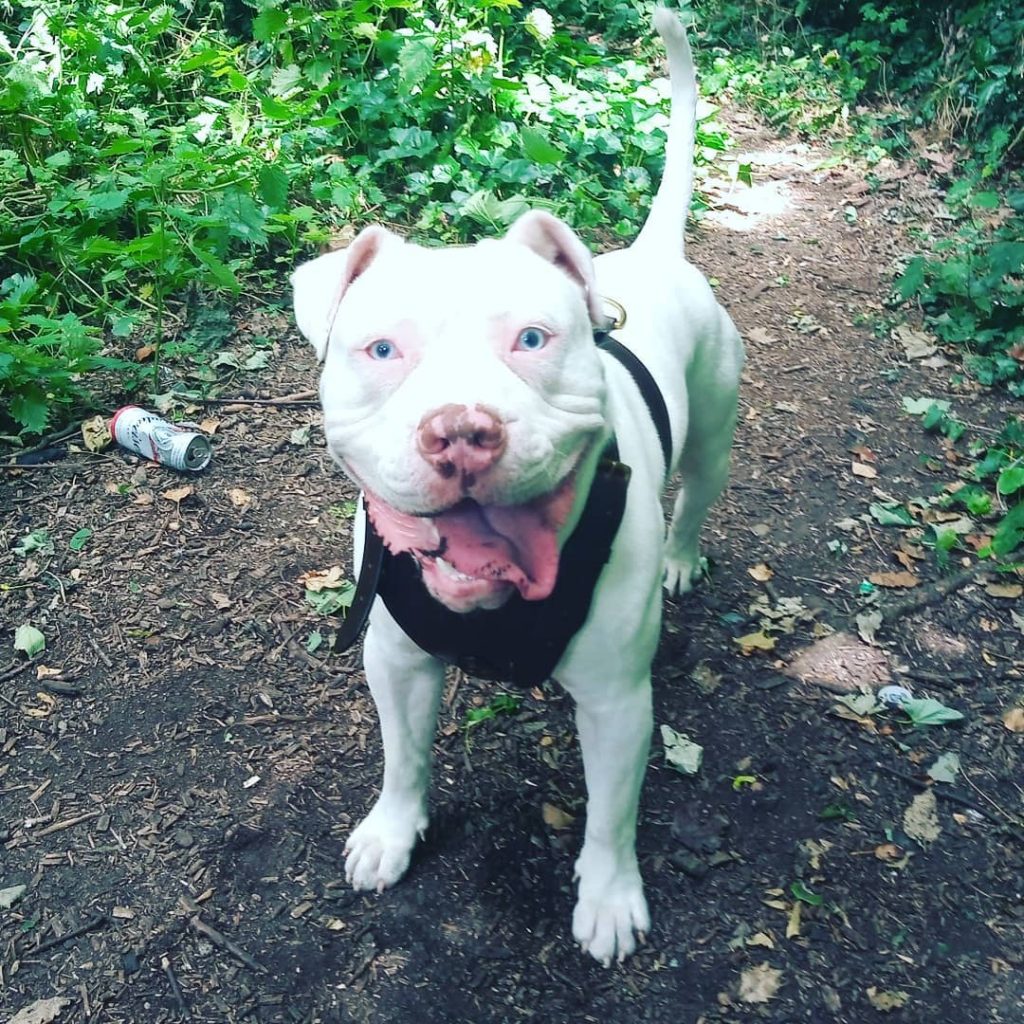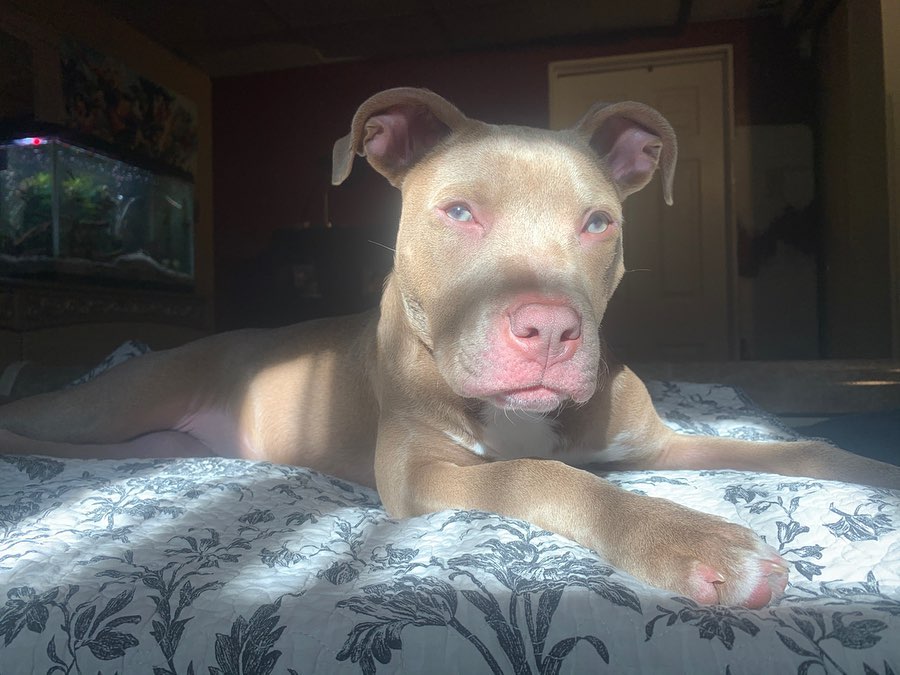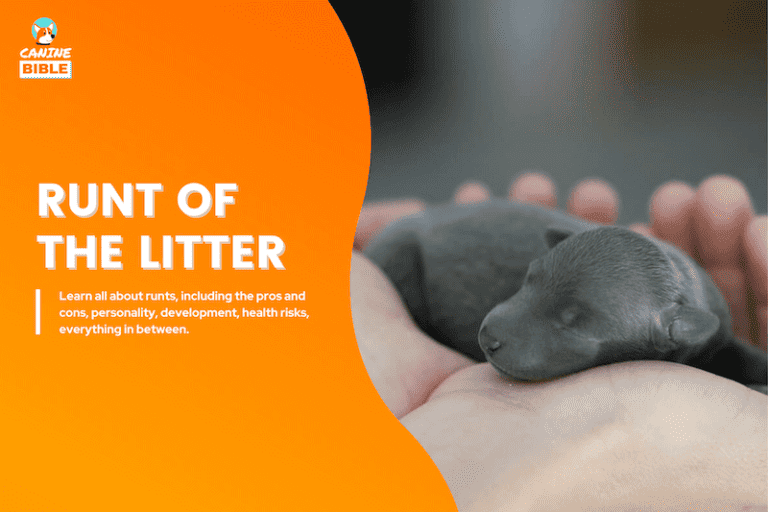Pit Bulls With Blue Eyes: Health, Risks, Pictures, Care, Tips & FAQs

Canine Bible is reader-supported. We receive affiliate commissions via some of our links. This doesn’t affect rankings. Learn more.
Is it possible for Pit Bulls to have blue eyes?
Yes, Pit Bulls can be born with blue eyes. However, while ice-blue eyes in Pit Bulls, particularly in puppies, may be irresistible, several concerns and potential risks are associated with this eye coloration.
If you own or are considering getting a blue-eyed Pit Bull, this guide will provide comprehensive information on health risks, potential dangers, causes, proper care, and more. It even includes stunning pictures of blue-eyed Pit Bulls. Let’s delve right into it!
- Why Pit Bulls Develop Blue Eyes
- Health Risks
- They Don’t Actually Have Blue Eyes
- Appearance
- Eye Color Characteristics
- Coat & Eye Color Relationship
- Blue Eyes By Coat Color (Pictures)
- Are Blue Eyes Not Acceptable?
- Blue-Eyed Pit Bull Puppies
- Will The Blue Eyes Change?
- Breeding Blue-Eyed Pit Bulls
- Price
- Blue-Eyed Pit Bulls For Sale
- Blue-Eyed Pit Bull Puppies (Video)
- Temperament & Personality
- History
- Conclusion
Note: Officially, the term “Pit Bull” is not a breed but a label for dogs descending from Bulldogs and Terriers. These dogs include the American Pitbull Terrier, the American Staffordshire Terrier, the Staffordshire Bull Terrier, and the American Bully. Some people may argue that the American Pitbull Terrier is the only Pit Bull type dog. However, for this article, we will use the word “Pit Bull” to refer to all of the above as they all share the same origins and genetic makeup of “Pit Bulls”.
Why Do Pit Bulls Have Blue Eyes?
Let’s explore the reasons why Pit Bulls develop those captivating blue eyes. While the majority of dogs typically have brown eyes as their default eye color, genetics, pigmentation, and health conditions can influence the eye color of Pit Bulls. However, genetics is the primary determinant of blue eyes in Pit Bulls. If your Pit Bull comes from a lineage with a history of blue eyes, there is a higher likelihood that they will also have blue eyes.
Here are three main reasons blue-eyed Pit Bulls exit.
The Merle Gene
Pit Bulls carriers of the merle gene (M-locus) are more likely to develop blue eyes. This gene is responsible for random pigment dilution (lightening) of the nose, eyes, and fur. However, being a carrier doesn’t always guarantee blue eyes in Pit Bulls or any dog.
The ALX4 Gene
A study where 6,000 dogs’ complete genetic profiles were analyzed, carried out by Embark Veterinary (one of the largest dog DNA testing companies), discovered that a genetic mutation near the gene known as ALX4 is strongly associated with blue eyes in dogs. Pit Bulls with this genetic mutation are more prone to be blue-eyed.
Melanin Levels
Melanin levels can influence the eye color of Pit Bulls. Melanin, a pigment in the iris, is another factor determining a dog’s eye color. Generally, dogs with higher melanin levels in their iris tend to have brown eyes. Conversely, a lower concentration of melanin results in lighter eye colors in dogs. So, what causes lower levels of melanin in a dog’s iris?
The gene responsible for modifying eumelanin, the black pigmentation in melanin, in Pit Bulls is known as the “M (merle) locus gene.” This genetic modification results in pigment loss, resulting in various eye colors in Pit Bulls, ranging from pale brown to shades of blue.
Blue-Eyed Pit Bulls Health Issues
Are blue-eyed Pit Bulls at higher risk of certain health conditions?
Genetically, having blue eyes in dogs typically does not indicate health issues. It is possible to have a perfectly healthy blue-eyed Pit Bull. However, it is important to note that blue-eyed Pit Bulls may have an increased likelihood of significant health risks compared to brown-eyed Pit Bulls.
Blue-eyed dogs (Pit Bulls) are prone to develop the following disorder:
Deafness
According to Washington State University, blue eyes in dogs are linked to hearing impairments. Pit Bulls, in particular are among the breeds predisposed to congenital deafness. The AKC Canine Health Foundation’s stated about a viral dog story where 4 out of 5 white coat Pit Bulls adopted by a police officer were deaf:
“The fact that all are white, and all are deaf is not an accident. Dogs with white or merle coats are predisposed to congenital deafness”
AKC Canine Health Foundation
Does this imply that all Pit Bulls with white or merle coats are susceptible to hearing loss?
No, not all white Pit Bulls or Pit Bulls with merle coats will necessarily be deaf, but they have a higher likelihood of experiencing partial or complete deafness. Deafness is present in certain dog breeds that carry the Merle and Piebald genes. The Merle gene is associated with congenital deafness, while the Piebald gene is responsible for the presence of spotted or multicolored coats in dogs. It is known that the Piebald gene can also contribute to deafness due to a lack of mature melanocytes (melanin-producing cells) in the inner ear.
If your Pit Bull puppy has blue eyes (due to the Merle gene), a spotted color coat (piebald gene), or a white coat, they may be at a higher risk of hearing loss. It is recommended to rule out congenital deafness by conducting a BAER test, which can be performed as early as six weeks of age. Hearing-impaired Pit Bulls are more susceptible to accidents, such as road traffic incidents, so it is important to take precautions to ensure their safety.
If you own a deaf Pit Bull, we advise you to learn effective communication methods for deaf dogs. Additionally, consider acquiring a collar specifically designed for deaf dogs and ensure your dog has an identification tag to promote awareness and safety for everyone in their vicinity.
Blindness
Pit Bulls with blue eyes may potentially develop vision defects. The presence of blue eyes in Pit Bulls can indicate that your pet carries the Merle gene, which is a dominant gene. However, it is essential to note that not all blue-eyed Pit Bulls will inevitably become blind. The likelihood of eye defects such as blindness is higher if both parents carry the Merle gene and pass it on to their offspring. Animals that are “double merle,” meaning they have two copies of the merle (M/M) trait, are primarily white and more susceptible to various health issues such as blindness.
Albinism
Pit Bulls that lack the genes required to produce melanin, the pigment responsible for skin, eye, and hair coloring, may be prone to albinism. The “M (merle) locus gene” is an example of a gene that modifies eumelanin, the black melanin pigment in dogs, leading to pigment loss. A significant reduction of this pigment throughout the dog’s body can result in albinism. Most of the dog breeds that experience congenital deafness often suffer from white pigmentation in their coats.
Other Eye Health Problems
Pit Bulls occasionally have eye conditions such as:
If you have concerns about your Pit Bull’s health, we suggest considering an at-home dog DNA test. This test can help identify whether your Pit Bull carries the gene(s) for blue eyes, other genetic disorders, or complications. We recommend the Embark Dog DNA Breed ID + Health kit, which tests for over 230 genetic health conditions.
By testing your dog, you will gain valuable insights that can enable you to take proactive measures today to manage, treat, or even prevent certain health conditions that may arise later in your dog’s life.
Given the susceptibility of eye problems in Pit Bulls, supplementing their diet with eye dog supplements like Zesty Paws Eye Supplement and using dog eye drops to provide long-lasting corneal protection and hydration can be beneficial.

Pit Bulls Don’t Actually Have Blue Eyes
Yes, you heard correctly. Although your Pit Bull’s eyes may appear blue, they are not truly blue. Allow me to clarify.
According to Geneticist Kristopher Irizarry from the College of Veterinary Medicine at Western University of Health Sciences, Pit Bulls and other dogs with blue eyes do not possess actual blue-colored eyes.
While brown eyes in dogs derive their color from melanin, dogs with blue eyes have colorless irises that lack any pigment. The coloration of blue eyes is achieved through a similar mechanism as the blue color of water and the sky. This occurs because all the light entering the eyes of a Pit Bull is scattered back into the atmosphere, creating the optical illusion of a blue appearance.
Pit Bull With Blue Eyes Appearance
Are blue-eyed Pit Bulls any different from brown-eyed Pit Bulls?
Blue-Eyed vs Brown-Eyed Pit Bulls
The primary noticeable distinction between Pit Bulls with blue eyes and their brown-eyed counterparts is the variation in eye color. Pit Bulls generally have a robust, muscular build and sport a short, smooth coat that can display various colors. They possess an athletic appearance characterized by strength and a whip-like tail that tapers to a point. Males typically reach heights of 11 to 13 inches and weigh between 20 to 28 pounds. Female Pit Bulls generally have similar measurements. However, the size and weight of Pit Bulls can vary due to their lineage, as they are a mixed breed resulting from different types of Bulldogs and Terriers. The breed’s trademark feature is its wide, square-like head and strong jaws.
Eye Color Characteristics
According to the United Kennel Club breed standard for Pit Bulls, Pit Bull’s eyes should be round, of medium size, set well apart, and low on the skull. All eye colors are acceptable except blue, which is considered a serious fault. So, what color eyes can Pit Bulls officially have? Eye color may range from dark brown to dark hazel and even green.
Blue-Eyed Pit Bulls & Coat Color
Is the color of the Pit Bull’s coat related to having blue eyes?
Yes, the coat color of a Pit Bull is related to the occurrence of blue eyes. The presence of blue eyes in Pit Bulls is often associated with certain coat colors and patterns, such as merle, white coats, or genes such as the Piebald gene, which is responsible for a pattern of unpigmented spots (or black and white patches) on a dog’s coat. However, it’s important to note that not all Pit Bulls with these coat colors or patterns will have blue eyes, as other genetic and environmental factors can also influence eye color.
On the other hand, solid coat colors are determined by the levels of melanin. Eumelanin, a type of melanin, produces the black pigment in a dog’s coat. However, genes like the Merle gene can affect the production of eumelanin in a dog’s cells. This alteration prevents the cells from producing a full-strength black pigment, resulting in various coat color shades ranging from gray, brown, tan, and everything in between.
Blue-eyed Pit Bulls with brown, black, grey, and silver coat colors are probably the most difficult and rarest of all blue-eyed pities. Why? Because the melanin levels are full-on black or closer to the black pigmentation. Also, the Merle gene is less likely to be present among these mentioned color coats.
Pit Bull With Blue Eyes Pictures — By Coat Color
Here are some blue-eyed Pit Bulls pictures with different coat colors.
White Pitbull With Blue Eyes
Check this white Pit Bull with blue eyes going about in the woods.

IG: @cherie_valentine_
Grey Pitbull With Blue Eyes
When you take a Grey Pit Bull with blue eyes shopping.

IG: @xl_hendrx
Black Pitpull With Blue Eyes
Black Pit Bulls with blue eyes are super rare. Since melanin levels are at their maximum, it’s nearly impossible for a black pitty to have blue eyes.
Tan Pitbull With Blue Eyes
This tan Pit Bull is taking a sunbath. His tan coat color is due to low-to-medium levels of melanin. The Merle gene may also be present.

Blue Nose Pitbull With Blue Eyes
Again, hard to find a blue nose Pit Bull with blue eyes due to the melanin level in the coat and possible merle absence.
Red Nose Pitbull With Blue Eyes
Blue-eyed red nose Pit Bulls are hard to find, but here is one.
Blonde Pitbull With Blue Eyes
Look at this handsome blonde Pit Bull with blue eyes!
Why Are Pit Bulls With Blue Eyes Not Acceptable?
The United Kennel Club, the APBT community, and most breed clubs do not consider Pit Bulls with blue eyes as desirable within the breed. This is because the presence of blue eyes in Pit Bulls is not commonly associated with the Merle and Piebald genes or the genes that cause blue eye coloration. As a result, Pit Bulls with blue eyes may not conform to the breed standard and may not be considered purebred. Considering this aspect before paying an additional price for a Pit Bull with blue eyes is important.
Blue-Eyed Pitbull Puppy
Are you thinking about getting a blue-eyed Pit Bull puppy?
When considering the purchase of a Pit Bull puppy with blue eyes, it is essential to ensure that this breed aligns with your personality and your family’s lifestyle. It is important to be ready for the addition of an energetic and friendly furry companion to your household. Whether you prefer a white Pit Bull puppy with blue eyes or a black one, we recommend prioritizing the puppy’s overall health rather than solely focusing on eye color.
Choosing whether to purchase from a reputable breeder or adopt a Pit Bull is a personal decision that requires thorough research. The AKC MarketPlace can be a useful starting point for finding Pit Bull puppies for sale in your area. It is important to seek a reputable breeder who can provide documentation of genetic health testing conducted on the parents and the Pit Bull puppy.
It is crucial to be aware that blue-eyed dogs have a higher likelihood of experiencing deafness and blindness. Responsible breeders will have tested the entire litter to ensure that all puppies have proper hearing and vision. If this testing has not been done, requesting it before bringing your blue-eyed Pit Bull puppy home is recommended.
Whenever possible, always consider fostering and adopting.
Will My Pit Bull Puppy Have Blue Eyes For Ever?
Are all pit bulls born with blue eyes? Yes, all puppies, including Pit Bull, are born with blue eyes because melanin production does not start until they are a few weeks old, so their eyes appear blue until now.
When Will Pit Bull’s Eye Color Start To Change?
Icy blue eyes on Pit Bull puppies are striking, to say the least, but do blue-eyed Pit Bull puppies stay blue? Not for long!
At 3 or 4 weeks old, most puppies’ eyes generally start to operate like those of adults, similar to the development of their permanent eye color. The majority of dogs end up with dark brown eyes. Some breeds, like the Siberian Husky, are the exception.
Your Pit Bull’s eyes usually change to their permanent eye color several weeks later. It often takes 9 to 12 weeks from birth for a puppy’s eye color to settle in and “stay.” The permanent eye color change can even happen as late as 16 weeks. True eye color shades can range from light brown, dark brown to amber to the rare permanent blue color.
Blue-Eyed Pitbull Price
From our research, breeders usually sell Pit Bull puppies with good bloodlines at starting prices of $2000 to $20000. However, you can also get Pit Bulls for as much as $800 to $3000. Reputable breeders will charge more as it costs a lot of money to keep dogs healthy to breed. They may also up the cost if what you are looking for is a blue-eyed Pit Bull.
Pit Bulls With Blue Eyes For Sale
If you are looking for Pit Bulls with blue eye puppies for sale, begin by looking at your local shelter. New pets are added every day, and they need their forever home. Great resources to start browsing for your next grey Pitbulls with blue eyes are the AKC Marketplace. Pawrade is another great resource, they are best place to find healthy, pre-screened teacup puppies from U.S.-based reputable breeders at a great price. Check with your local breeders as well.
Blue-Eyed Pit Bull Puppies In Action
Check out these beautiful Pit Bull puppies with blue eyes. Ugh, they are so adorable.
Temperament & Personality Of A Pit Bull
What can you expect from Pit Bulls? The Pit Bull, also known as “Pitties,” is a loyal, protective, and athletic canine breed.
Despite the negative stereotypes and misconceptions associated with this breed, temperament studies on dogs show that pitties rank high among the most affectionate, tolerant, and least aggressive dogs. Research conducted by the American Temperament Test Society, pit bulls passed at a rating of 86.4%, higher than popular breeds such as golden retrievers, corgis, and beagles.
According to Pamela Reid, Ph.D., vice president of the ASPCA’s Animal Behavior Center in New York, generally, pit bulls aren’t aggressive with people but are “less tolerant” of other dogs than many other breeds. This Pit Bull is eager to please and brimming with enthusiasm. They make excellent family companions and have always been noted for their love of children. As with all breeds, pit bulls should be supervised when with children. Pit Bulls tend to be stubborn, tenacious, and fearless. This breed will require plenty of exercise and a strong pack leader. They are very obedient dogs. However, proper training must be provided from an early age.
Do you still think Pit Bulls are bad or vicious? We advise you to read Pit Bulls, America’s Most Beautiful (and Misunderstood) Pet to understand why negative stereotypes have dogged the pit bull and learn why pit bulls are innately wonderful family pets.
Pit Bulls are powerful chewers and very determined dogs that can destroy a toy in seconds. We recommend getting a dog subscription box for heavy chewers like Pit Bulls. They are designed not to break and provide the most optimal stimulating experience for this breed’s personality type.
Breeding Pit Bulls With Blue Eyes
One reason why breeding Pit Bulls with blue eyes is sometimes frowned upon, considered unethical, and inhumane by some is because of the increased likelihood of health issues in the puppies. When two merle (Mm) carrier dogs are bred together, the chances of producing a double merle (MM) litter significantly increase. Double merle puppies are extremely prone to genetic diseases such as deafness and blindness.
While blue-eyed Pit Bulls can still produce healthy offspring, their puppies are more susceptible to being born with congenital health issues compared to puppies born from a single merle carrier (Mm) and a non-carrier (m/m).
To ensure responsible breeding practices, it is recommended to breed a Merle Pit Bull only with a non-merle/non-cryptic Merle dog. When breeding Pit Bulls, it is essential to select a female and male from healthy bloodlines. Breeding Pit Bulls with blue eyes should follow the same standards as breeding non-blue-eyed Pit Bulls.
It is advised to wait until the female Pit Bull is two years old and after her second heat cycle before breeding. It is also important not to breed female Pit Bulls in two consecutive heat seasons to allow sufficient time for recovery. The expected litter size typically ranges between 5 and 10 puppies.
History of The Pit Bull
The United Kennel Club states that the American Pit Bull Terrier (APBT) was created by crossbreeding Old English Bulldogs and terriers to produce a dog that combined the bulldog’s strength with the terrier’s gameness and agility. The Pit Bull Terrier also gained popularity on the British Isles for the sport of bull-baiting, where one to two APBTs were set to harass a bull for hours until the animal collapsed from fatigue, injuries, or both. When bull-baiting was outlawed, the APBT was used for dogfighting and ratting, a betting sport where people bet to see whose Pit Bull could kill the most rats in the least amount of time.
Immigrants brought these bull-and-terrier crosses to the United States. As these cruel sports became less popular, the APBT talents did not go unnoticed. Pit Bull Terriers became farm dogs and family companions. The “Pit” in Pit Bull comes from ratting as the rats were placed into a pit so that they could not escape. If you want to learn more about the controversial story of one infamous dog breed, the New York Times Bestseller “Pit Bull: The Battle over an American Icon” is a must-read for any Pit Bull lover.
Should You Get A Pit Bull With Blue Eyes?
Generally, Pit Bulls are fantastic family pets. Pit Bulls are a loyal, people-oriented breed that thrives as part of the family. They are affectionate with both adults and children and love to cuddle. They are happy dogs with huge smiles and infectious zest for life. They are very active dogs requiring lots of exercises, so a pitty might not be a good choice if this doesn’t fit your lifestyle. Being confined in a small space may yield destructive behavior in your Pit Bull.
You need to be willing to invest the time and effort in training your Pit Bull. A well-trained pitty is a happy pitty. If you are set on getting a Pitty, canine author Erin Hotovy offers the best advice to raise a happy, healthy Pit Bull on The Complete Guide to Pit Bulls.
One of the biggest downfalls of owning a Pit Bull with blue eyes is the health concerns we covered in this article. You need to do your research to find a healthy blue-eyed Pit Bull.
Like It? Subscribe & Share!
Canine Bible authorship represents the unified voice of our entire editorial team and our in-house veterinarians rather than a single author. Each article, blog post, and review published under the Canine Bible name undergoes a rigorous review process, involving all team members to guarantee accuracy and up-to-date in accordance with the latest veterinarian research. This collaborative effort is an integral part of our editorial process and aligns with our four pillars of content creation. This approach ensures our content is backed by expert knowledge and factual information, offering our readers reliable, actionable, and trustworthy content.









